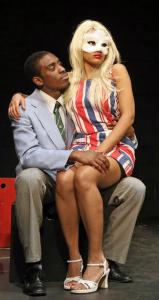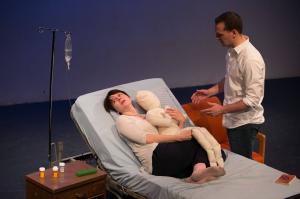
|
Three Plays about the Darkness in the Soul
Recently I saw performances of three plays that are quite distinct from each other in content, style, provenance, and venue. And yet, I found a common essence shared by all three. We may feel but do not understand the darkness in our own soul and, we cannot fathom what lies beneath the surface of another person. All three productions also shared a passionate approach to their subject. The three productions were: "Dutchman" (Feb 5 - March 8, 2015) by Amiri Baraka (1934-2014), produced and directed by Woodie King, Jr. and the New Federal Theatre in association with Castillo Theatre; "Drifting," (March 4, 2015) a new play by William Doan, directed by Andrew Belser, produced at Penn State University and performed at Dixon Place; and "Kafka's Quest a.k.a Kafka/Samsa" (Feb 16 - March 15, 2015) by Lu Hauser, directed by Manfred Bormann and produced by Theatre for the New City.
The best known and by now a classic of modern American theatre, "Dutchman," set in a New York subway, attained a rich poetic texture and multi-layered depth of meaning in Mr. King's rendering. The play's title refers to the slave ships owned by the Dutch West Indies Company that plied the Middle Passage between Africa and the Americas; it also evokes Richard Wagner's music for his opera, The Flying Dutchman about the death-bound love between the captain of a ghost ship and a self-sacrificial woman. Both motifs were used before the start of the play with the projection of African masks onto the subway window screens together with Wagner's leitmotif from the opera suggesting the collective tragedy. This set the expectation for a more differentiated interpretation of the play than the angry black play of (then) Leroi Jones as it was seen in the 60s. The performances that followed fulfilled those expectations brilliantly. On the small stage of the Castillo Theatre Chris Cumberbatch designed a subway car with rows of seats fanning out stage left and right, scrim windows, poles, and a sliding door upstage center for entrances. This was the arena for the "slow dance" between Clay and Lula on the emotional "killing ground." Michael Alcide, a fine actor who started his acting career with Youth Onstage at Castillo, takes us on Clay's infernal journey of African-American suffering that corrodes the soul, even of those who accomplished the first steps into social acceptance. Mr. Alcide had an equal partner in Ryan Jillian Kilpatrick as Lula. Ms. Kilpatrick, herself a light-complexioned African-American woman wore a white half-mask adorned with pearls, like a carnival mask, which she never took off. Her feral energy, throaty voice, and masked face made Lula into a dangerously seductive force of nature. Their accelerating game of verbal stripping to the raw bone of pain is played out in front of a chorus of white masked black riders. Their silent presence with periodic outbursts of mocking laughter only emphasizes Clay's agony amidst human indifference. Lula's murder of Clay, his being dispatched into the anonymous grave of a subway tunnel, and her beginning a new round of seduction with another young black man, while being very specific dramatic actions, achieve in Woodie King, Jr.'s stylized production a larger metaphorical dimension that encompasses the history and the present state of race and social relations in our contemporary world.
"Drifting" by William Doan is a deeply personal play about relationship, in this case, a brother-sister relationship under the strain of the sister’s comatose condition due to traumatic brain injury. Set in a hospital room, simply suggested by a bed, an IV stand, and a generic chair next to the bed, the drama unfolds bit by bit the complications between the half siblings—same mother but, for the brother, a resented step-father. However, more importantly, the play deals with the important question of how we confront the "living death" of a loved one who is locked into a coma. Society, the law, and the medical profession demand certain procedures. The comatose human being is helpless, and the next of kin feels torn between hope and despair. Intra-familial tensions and varying vestiges of Catholicism, albeit lapsed in the case of the siblings, but active in the case of the mother, absent from the stage but present in their conscience, make for a potent dramatic conflict. These are the "reality" driven sources of the dialogue among the three characters: ME, SHE, and HE (the nurse). However, what Bill Doan has created on stage together with the director, Andrew Belser, and three imaginative exacting young actors is a work of theatrical poetry that took full advantage of the open theatre space at Dixon Place where the audience could follow the staging as in an operating room. (Unfortunately, at this point, there was only one performance in New York.) The play opens with the sound of labored breathing as we look upon an inert young woman on a hospital bed holding tightly against her twisted body a featureless life-size cloth puppet. A young man sits in a chair next to her. A flutter of her eyelids, her head moves slowly, she gets out of bed as though in a trance and begins to sway dance to some inner music. And from this moment, the play moves in and out of different levels of consciousness and layers of reality. The part of SHE, played beautifully by Megan Pickrell, is a haunting tour de force of intense movement and vocal gymnastics as she projects the inner life of the comatose sister where memory and present condition mingle freely. The life-size cloth puppet, the Body in the Bed, represents the outer shell of SHE attended to by HE, played by Jake Wentlent with the professional competence and emotional distance of a nurse. ME, the brother, played with deep sincerity by Aaron Densley remains firmly planted in the painful present and has the task to respond to his sister's challenges and be a voice for thousands of people who deal with the conundrum of not knowing who is truly left behind the dead shell of a comatose loved one but who are ultimately expected to make a life-death decision for that person, if there is legal clarity. The play reveals a profound philosophical problem rooted in the American psyche: the acceptance of death as a natural and inevitable part of life rather than a sign of terminal disease to be conquered or postponed at all cost. "Kafka's Quest a.k.a. Kafka/Samsa" is a play loosely based on Kafka's life before he wrote The Metamorphosis. Lu Hauser (1924-2011) composed from Kafka's early diaries, writings, and biographical information an imaginative play that combines scenes from his home life and confrontations with his father, Hermann Kafka/Samsa, as well as scenes that intimate his friendship with the Yiddish actors, Itzhak Loewy and Mme. Trassik at the Café Theatre Savoy in Prague and scenes with two ominous Kafkaesque characters. The central character throughout is Gregor Samsa who is pre-occupied with his relationship to his father and his ultimately futile attempts to find understanding and acceptance of himself and of his father. Under Manfred Bormann's direction, the play moved with elegant clarity in which the actors were able to perform the abrupt rhythm changes demanded by the rapid-fire sequence of associative events and dialogue.
Gregor Samsa/Franz Kafka, played by Dana Watkins with subtlety, passion, and humor is first seen writing a letter to his father after an unsuccessful journey as a traveling salesman. (Throughout the play he will write several letters.) His first words, "Dearest Father" are followed by a comment that encapsulates the essence of his alienation—what is to me a "mysterious" set of circumstances is to you simply a streak of "bad luck" caused by my own feebleness. These are two fundamentally different viewpoints for seeing oneself in relation to one's world. Gregor is an artist but locked into earning the upkeep of his family. His father, played by G.W.Reed, is a bankrupt businessman locked into his own impotence. The befuddled mother Julie, played by Cordis Heard, does not comprehend either of these men. Servant girl Elsie, portrayed by Sara Barnett with subservient guile, completes the household. Until the two lodgers arrive: Mr. Ordnung and Mr. Damstag (played by, respectively, Paul Battiato and Matt Walker), are officials at the Registrar's Office of the Certification of Death. The two arrive at the Samsa household, dressed in black with black umbrellas and black bowler hats, moving in perfect synchrony. Their presence dominates the home as they take over more and more space. One action shows Gregor's father and mother moving a heavy chest of drawers across the stage to Gregor’s room. Gregor enters just in time to see his father having heart problems. As he stops the move, it becomes an absurd tussle between father and son with the chest in between. More importantly, the two lodgers terrorize the family psychologically by instilling a typical Kafkaesque sense of non-specific guilt by their non-sequitur comments and mysterious note-taking. Gregor escapes by associating with his Yiddish actor friends at the Savoy, although his father had tried to poison this relationship also by shouting after him, "lie down with dogs and you wake up with fleas." He even tries to write a play for them. Lu Hauser humanizes the actors' plight by having them do double duty as sellers of hot sweet potatoes to subsidize their income.These scenes include some musical interludes with Stanley Walden's striking compositions for this play, a bit like some distorted Kurt Weill couplets, sung by the zaftig Mrs. Trassik and performed most passionately by Nikki Ferry and her acrobatic partner, Derrick Peterson who exudes an indomitable joie de vivre, wit, and warmth. In fact, the most humane among the characters are the two actors struggling at the existential margins of society—they are the proverbial "hunger artists." The contrasting interplay of hidden versus surface reality, of the
paradox of attraction and repulsion in human relationships, of the
contradictions embedded in the human soul are depicted visually in
this production in the brightened and darkened faces produced by sparse
lighting from the side (designed by Yuki Nakase). The last voice in
the play is Kafka. The beginning of The Metamorphosis, in which Gregor
Samsa awakes feeling himself as an insect, like the monstrous dung
beetle of his father's narration in the play, is heard and then read
by Gregor as his family and the lodgers assemble around and behind
him in a final tableau.
|
| museums | NYTW mail | recordings | coupons | publications | classified |


